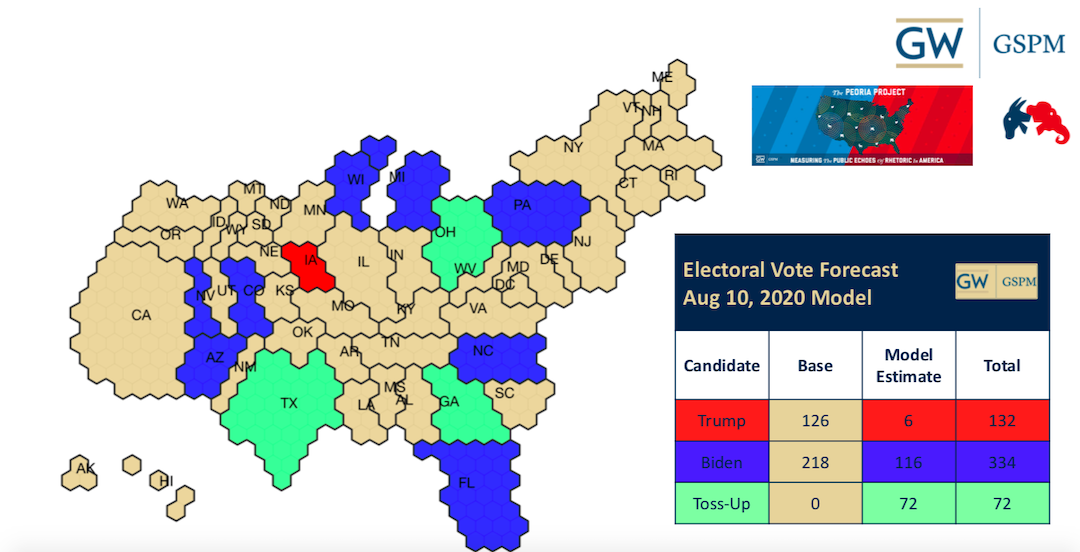By Tatyana Hopkins
According to a new election prediction model developed by the George Washington University Graduate School of Political Management, former Vice President Joe Biden will win November’s presidential election.
The first iteration of the PEORIA Project’s new election prediction model, which measures the pulse of public conversations about political campaigns to develop forecasts for 12 battleground states, projected that Mr. Biden will take the election with a nearly insurmountable lead of 334 votes in the electoral college against President Donald Trump, who it projects will get 132 electoral votes.
Using 38 states and Washington, D.C., as base-states for either party, it found battleground states Georgia, Ohio and Texas to be toss-up states between Mr. Biden and Mr. Trump, leaving 72 electoral votes up in the air. However, the model projected that Arizona, Colorado, Florida, Michigan, Nevada, North Carolina, Pennsylvania and Wisconsin would go with Mr. Biden while Iowa was projected to go with the Republican candidate, Mr. Trump.
The model, which will publish projection updates every two weeks on Tuesdays until the election on Nov. 3., was unveiled Tuesday at a virtual event hosted by GSPM, “Blue Wave: Taking the Partisan Pulse in 2020,” where political experts at GSPM presented a data-driven analysis of the 2020 presidential race from the beginning of the year to now, along with a projection of how the election might turn out in November.
The panel of GSPM experts included Lara Brown, the school’s director; Todd Belt, political management program director; Casey Burgat, legislative affairs program director; and Michael Cornfield, professor and research director.
During the event, the experts analyzed the results of the most recent GW Politics Poll, with particular attention to how Democratic voters view the political landscape, how they feel about the candidates on the ballot, and other GSPM election research projects.
The group’s data also correctly indicated Mr. Biden’s vice president pick just hours before it was announced.

GSMP new election prediction model, PEORIA Project, predicted a win for former Vice President Joe Biden against President Donald Trump in November's election.
“By a 2:1 margin among Democrats, and it’s closer to 3:1 for Republicans, Kamala Harris is the talk of the nation when it comes to the VP candidate,” Dr. Cornfield said. “It’s not a hard and fast rule that talk [online] leads to reality, but it certainly is an indication of the familiarity people will have and the interest people will have with the various possibilities.”
The group noted that despite the various factions and policy opinions that reside within the Democratic Party, especially in its highly contested presidential nomination race, the party is highly unified on one central goal—ousting President Donald Trump in the upcoming election.
“Democrats want to beat President Trump, and they’re willing to put forward a nominee who puts forward moderate positions to do it,” Dr. Brown said. “And they are not stuck on whether or not they are in love with their nominee or their party platform as much as they are focused on removing President Trump.”
While discussing a GSPM panel survey, which examined the attitudes of Democratic and Democratic-leaning voters over time, Dr. Belt said about a third of Democratic voters were expressive attentive voters—who use social media to express their opinions about a political candidate, issue or event.
He said although there is a “bit of fissure” between expressive attentive Democratic voters, who tend to be more liberal, and other Democratic voters, Mr. Biden has the group’s support, noting that there was no statistical difference in their support of him.
“That was really, really, really important,” Dr. Belt said. “Although they are much more pro-Bernie, they weren’t necessarily anti-Biden. So, this really means that there is a big opportunity for Biden to reunite the party. It doesn’t look like they’re going to bolt from the Democratic Party and this election at this time.”
Dr. Burgat said Democrats are strongly motivated by the desire to remove Mr. Trump from office.
“There’s a huge disconnect between Democrats and Republicans for why they are voting for who they are voting for,” he said while previewing a GSPM cross-sectional survey of 12,000 voters.
On the Democratic side, he said, many voters are not voting against or for Mr. Biden, instead their number one motivation for voting is to “vote [the president] out,” while a vast majority of Republican voters said their leading motivation for voting Republican is supporting Mr. Trump.
However, he said things do not look great for Mr. Trump.
“From February to June Trump’s approval rating dipped eight points to 41 percent, while Biden’s approval rating rose nearly 13 points to 46.5 percent,” Dr. Burgat said. “The president’s approval rating is slipping down to dangerous marks—to the mid-30s and low 40s in each of the battleground states. I can’t imagine that these numbers are getting better for [him].”




